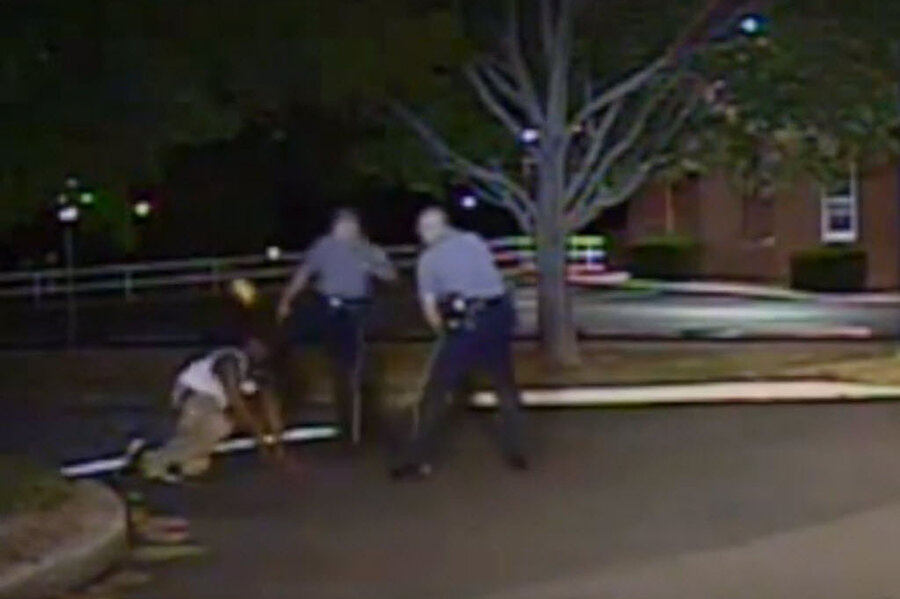In arrest of cop for kicking black man, signs of shift on prosecuting police
Loading...
| Atlanta
A Dover, Del., police officer who faced no criminal charges in 2013 for knocking a surrendering man unconscious with a jaw-breaking kick could face jail time, after all.
In 2013, then-attorney general Beau Biden (Vice President Joe Biden’s son) failed to get a grand jury indictment against Cpl. Tom Webster for injuring Lateef Dickerson without cause. But a judge in a civil rights lawsuit recently ruled that a video of the event could be released publicly, and current Attorney General Matt Denn brought the case again, resulting in an indictment for second-degree assault Monday.
In the aftermath of Ferguson, Mo., video evidence has played a decisive role in at least one case against a police officer accused of excessive force against black suspects. In North Charleston, S.C., police brought murder charges against the officer who shot a fleeing black man in the back and then appeared to plant evidence to suggest the man had been armed with a Taser. Officials admitted that no charges would have been brought if a bystander had not recorded the shooting.
Together with the Delaware case and the broader scrutiny of police behavior since Ferguson, the incident could point to the emergence of a nascent shift in how prosecutors view police abuse allegations caught by on-the-scene video footage. The steady stream of video, experts say, is making at least some small dent in police credibility in use-of-force cases.
“Where in the past juries have been deferential to official statements and generally discounted statements from citizens who might be a suspect, or portrayed as a suspect, these videos are now proving very transformative, because they diminish that deference that juries have for the official version of events,” says Frank Baumgartner, a political scientist at the University of North Carolina in Chapel Hill.
He does not suggest that the recent videos represent a stain on the entire profession.
“I don’t think these incidents reflect a really high percentage of police behaviors,” he says. “But where we’ve been led to believe that there’s basically zero inappropriate use of force, maybe there’s 100 per year, and all of a sudden we’re seeing them.”
With more police departments mandating body cameras for patrol officers – including Los Angeles last week – prosecutors could be facing this situation with increasing frequency going forward. Mr. Baumgartner points out that prosecutors need the public to trust the police in order to get convictions in court, so public outcry over the issue could affect their judgment.
Last week, Baltimore state prosecutor Marilyn Mosby brought a range of charges including murder and manslaughter against six police officers in the death of Freddie Gray. While video of Mr. Gray did not show the moment when he suffered a fatal neck injury, it did appear to show him in physical distress and brought attention to the case.
The Dover case suggests a willingness by a prosecutor to reopen an old case based on video evidence alone. Attorney General Denn, who took office in January, acknowledged that he had been watching the post-Ferguson police use-of-force cases closely, writing on Facebook that he has refrained from posting his opinions about “some of the more visible cases that have been in the news” because of prosecutorial rules. But he noted that “it can be frustrating not to be able to share what I know about some of these cases ….”
The Delaware video shows an officer responding to a fight possibly involving a gun. The officer pulls up to the scene, where a black man in a ball cap is standing. The man raises his hands as Corporal Webster can be seen approaching from the left side of screen, ordering him to the ground. As Mr. Dickerson in the process of complying with the order, Webster kicks him, knocking Dickerson unconscious, sending his baseball cap flying, and breaking his jaw.
Webster’s attorney, James Ligouri, has said another, as-yet unreleased cruiser dash cam video will lead to Webster’s acquittal. The attorney told the News Journal of Wilmington, Del., that Webster had to use force to arrest Dickerson. In an interview with the News-Journal, Mr. Ligouri called the indictment “suspect” because it coincided with a settlement phase in a civil lawsuit. He referred to Dickerson’s injuries at the hands of Webster as an "ancient matter."
But leaders in the black community say the video shows that the allegations long made against police are not fabrications.
“I think what is good about this moment is that the use of electronics are giving confirmation to what black young men have been saying … for decades,” the Rev. Donald Morton, a Delaware civil rights leader, tells the News Journal. “We no longer have to take their word. We see it.”
Police say Webster’s actions broke department policy, but the extent to which he was reprimanded in 2013 is not clear. Webster was reinstated with pay in January 2014 and reassigned to patrol duty. This week, he was arrested, suspended without pay, and paid a $5,000 bond to be released.
Delaware officials have called for peace as the state’s case against Webster goes forward.
“Now is the time for patience as the justice system considers all of the facts and circumstances of the fact,” Gov. Jack Markell said in a statement. “Police agencies and the communities they serve must trust one another. Situations like this can erode that trust, and we need to be committed every day to a dialogue of respect and understanding for the rights of citizens and the challenging jobs we ask our police to do every day.”








